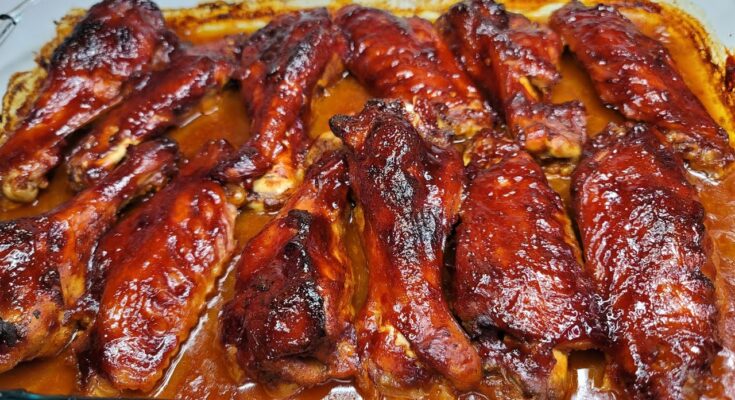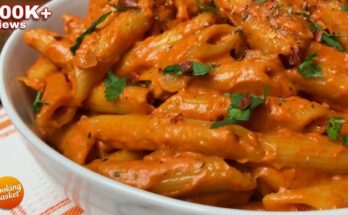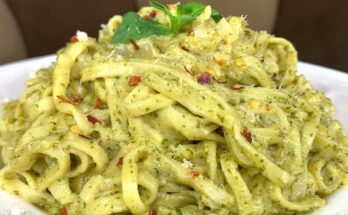Turkey Wings Recipe: Turkey wings are more than just an alternative to chicken—they’re a soul food staple that packs a ton of flavor and nostalgic comfort. Growing up, Sunday dinners weren’t complete without a tray of tender, juicy turkey wings simmering in their own seasoned juices. Whether smothered in gravy, slow-cooked, or baked to crispy perfection, turkey wings have a special place in hearty home-cooked meals.
What makes turkey wings special is their size and flavor profile. They’re larger and meatier than chicken wings, which means they absorb seasonings deeply and develop a richer flavor during cooking. When cooked low and slow, the meat becomes fall-off-the-bone tender—perfect for pairing with mashed potatoes, rice, or collard greens.
People love turkey wings because they strike the perfect balance between indulgence and wholesomeness. Unlike the entire bird, turkey wings are easier to prepare in smaller batches, making them ideal for weeknight dinners or small family gatherings. They also reheat well, which means leftovers are just as delicious the next day.
Nutritional Benefits of Turkey Wings
Despite their comfort-food status, turkey wings actually offer some decent health benefits—especially when baked instead of fried. They’re high in protein, which is essential for muscle growth and repair. A single turkey wing provides around 22–28 grams of protein, depending on size and preparation.
They also contain important vitamins and minerals like iron, zinc, and B vitamins. Iron helps your body transport oxygen, zinc boosts immunity, and B vitamins are vital for energy production. Yes, turkey wings do have fat—especially in the skin—but baking or trimming can reduce that if you’re watching your intake.
Overall, turkey wings are a satisfying source of nutrition when prepared thoughtfully. If you’re on a low-carb or keto diet, these wings (minus the sugary sauces) are a perfect fit. And if you’re just looking for something delicious and filling, turkey wings are always a win.
Ingredients You’ll Need
Basic Ingredients
Let’s get right to it. To make mouthwatering turkey wings, you don’t need a mile-long grocery list. In fact, most of the ingredients are likely sitting in your pantry already. Here’s what you’ll need for a basic, no-fail recipe:
- Turkey wings – About 3–4 large wings, preferably split at the joint.
- Olive oil – Helps lock in moisture and crisp up the skin.
- Garlic powder – For that deep, aromatic flavor.
- Onion powder – Adds a sweet and savory undertone.
- Paprika – For color and mild smokiness.
- Salt – To bring out all the natural flavors.
- Black pepper – Freshly ground is best for a bold kick.
- Thyme or rosemary – For a herby note.
- Chicken broth or water – Keeps the wings moist during baking.
These form the foundation of a great turkey wing dish. You can stop here and still have a flavorful outcome, but keep reading if you want to kick things up a notch.
Optional Add-ons for Extra Flavor
If you’re someone who loves bold, standout dishes, try adding:
- Chili flakes or cayenne – For a bit of heat.
- Smoked paprika – To deepen the smoky flavor.
- Butter – Adds richness when melted over the top.
- Fresh garlic cloves – For an earthy depth.
- Lemon juice or zest – For a hint of acidity and freshness.
- Worcestershire sauce – A splash goes a long way in adding umami.
You can also make a simple marinade using olive oil, soy sauce, mustard, garlic, and herbs for overnight soaking. This gives the wings more time to soak up flavor.
Ingredient Substitutes You Can Use
No thyme? Use Italian seasoning. Out of olive oil? Try avocado or canola oil. Watching your sodium? Opt for low-sodium broth and cut back on added salt.
You can also switch up the flavor base entirely. Want something sweet and spicy? Use honey and hot sauce. Craving BBQ? Use a smoky rub and your favorite barbecue sauce toward the end of baking.
Kitchen Tools Required
Must-Have Equipment
Let’s keep it simple. You don’t need a fancy chef’s kitchen to pull this off. Here’s what you absolutely need:
- Baking dish or sheet pan – Preferably deep enough to hold liquid.
- Aluminum foil – Helps trap heat and moisture for tender meat.
- Mixing bowl – For tossing wings with seasoning or marinade.
- Tongs – Makes flipping and handling wings safer and easier.
- Meat thermometer – Optional, but great for checking doneness.
Having these essentials makes cooking smoother, faster, and cleaner. Trust me—you’ll thank yourself for using the right tools.
Helpful Extras for Better Results
Want to step it up?
- Wire rack – Place it on a baking sheet to let hot air circulate and crisp the skin.
- Basting brush – Perfect for spreading sauce or butter evenly.
- Gravy separator – If you’re planning to use the drippings for sauce.
- Food processor – If you’re making a fresh marinade or rub.
These extras aren’t mandatory but can elevate your cooking from basic to pro-level with minimal effort.
Prepping the Turkey Wings
Cleaning and Trimming the Wings
Before seasoning, you’ve got to prep the turkey wings properly. Start by rinsing the wings under cold water. Some people like to soak them in a mix of water, lemon juice, and vinegar to remove any gamey smell. It’s not a must, but it does freshen them up.
Once rinsed, pat them dry with paper towels. This step is important—moisture prevents the skin from crisping up. Check for any leftover feathers or cartilage and remove them. If your wings are whole, consider splitting them at the joint for easier handling and faster cooking.
Trimming excess skin and fat can also help if you’re aiming for a leaner result. Just don’t go overboard—you want to keep enough skin on for flavor.
Seasoning Techniques and Marinade Tips
Now comes the fun part: seasoning. Combine your dry spices in a bowl. Coat the wings lightly with oil, then sprinkle the spice blend generously. Rub it in well, making sure every inch of the meat is covered. You can even lift the skin slightly and rub the spices underneath for deeper flavor.
If you’re marinating, place the wings in a sealed bag or container with your liquid mixture and refrigerate for at least 4 hours—overnight is even better. The longer the wings marinate, the more flavorful they’ll be when baked.
Pro tip: Always bring the wings to room temperature before baking. Cold meat straight from the fridge cooks unevenly and can toughen up.
Step-by-Step Guide to Cooking Turkey Wings
Step 1 – Preheat and Prepare the Oven
Preheat your oven to 375°F (190°C). Line a baking dish or sheet pan with foil for easy cleanup, and lightly coat it with oil or non-stick spray. Pat the turkey wings dry with paper towels—this helps them crisp up beautifully.
Step 2 – Arrange and Bake the Wings
Place the wings in a single layer. Season generously with salt, pepper, garlic powder, paprika, and a drizzle of olive oil. Bake uncovered for 45 minutes.
Step 3 – Baste and Flip for Juiciness
Flip the wings halfway through baking and baste them with their own juices or a little butter to keep them moist.
Step 4 – Check Doneness and Texture
Continue baking until golden brown and the internal temperature hits 165°F (74°C).
Step 5 – Serve and Enjoy
Let them rest for 5 minutes before serving. Serve with hot sauce, BBQ glaze, or a honey-garlic drizzle—crispy, juicy perfection every time!
Alternate Cooking Methods
Air Fryer Turkey Wings
Don’t want to turn on the oven? Air fryers are a great option for making turkey wings faster without sacrificing flavor. Preheat your air fryer to 375°F (190°C). Lightly coat the wings in oil and seasoning, then place them in the basket in a single layer.
Cook for 25–30 minutes, flipping halfway through. You’ll still get crispy skin and juicy meat, plus it’s a healthier option since you’re using less oil and fat. Perfect for busy weeknights.
Slow Cooker Turkey Wings
Want fall-off-the-bone tenderness? The slow cooker is your best friend. Place seasoned wings in the pot, add about a cup of broth or water, and set it on low for 6–7 hours or high for 3–4 hours.
You can finish them under the broiler for a few minutes to get the skin crispy. This method is foolproof and gives you tender meat that practically melts in your mouth.
Grilled Turkey Wings
For smoky, charred flavor, nothing beats the grill. Marinate your wings ahead of time, then grill over medium heat for about 40–45 minutes, turning every 10 minutes. Baste with sauce during the last 15 minutes for sticky, smoky perfection.
Grilling gives you a rich, outdoor BBQ flavor that pairs perfectly with summer sides like corn on the cob and baked beans.
Side Dishes That Pair Perfectly
Southern-Style Sides
Turkey wings shine when paired with rich, hearty southern classics. Here are a few to consider:
- Collard greens – Slow-cooked and seasoned with smoked turkey or bacon.
- Macaroni and cheese – Baked with a cheesy crust on top.
- Candied yams – Sweet and sticky with brown sugar and cinnamon.
- Cornbread – Soft, buttery, and perfect for soaking up juices.
- Mashed potatoes and gravy – Creamy, fluffy, and always a crowd-pleaser.
These sides balance out the savory richness of turkey wings and create a soul-warming meal.
Healthy Pairings
If you’re trying to lighten things up, try these sides:
- Steamed green beans with garlic and lemon.
- Roasted Brussels sprouts with balsamic glaze.
- Cauliflower mash as a low-carb alternative to potatoes.
- Quinoa salad with cucumbers, tomatoes, and feta.
- Mixed greens with vinaigrette for a refreshing bite.
These options add color, crunch, and balance without weighing down your plate.
Storing and Reheating Leftovers
Best Practices for Storage
Cooked turkey wings store well and taste just as delicious the next day—sometimes even better after the flavors have had more time to settle in. To store them properly, let the wings cool completely at room temperature for about 20–30 minutes (don’t leave them out longer than 2 hours).
Once cooled:
- Place the wings in an airtight container or wrap them tightly in foil or plastic wrap.
- Add a bit of the leftover pan juices or broth to the container to retain moisture.
- Store in the refrigerator for up to 4 days.
- For longer storage, freeze the wings. Wrap them individually, place them in a freezer-safe bag or container, and label them with the date. They’ll keep for up to 3 months in the freezer.
Remember to always store wings in shallow containers to allow them to cool evenly and prevent bacterial growth. Safe storage ensures your leftovers are both tasty and safe to eat.
Reheating Without Drying Out
Reheating turkey wings without losing their juicy texture can be a bit tricky, but here’s how to do it right:
Oven method (Best for texture):
- Preheat oven to 325°F (160°C).
- Place wings in a baking dish and add a splash of broth or water.
- Cover tightly with foil to trap steam.
- Bake for 15–20 minutes or until warmed through.
Microwave method (Faster option):
- Place wings on a microwave-safe plate.
- Cover with a damp paper towel or microwave cover.
- Heat in 30-second intervals until hot.
Air fryer method (For crispy skin):
- Set air fryer to 350°F (175°C).
- Heat wings for 5–7 minutes, checking halfway through.
Avoid reheating wings too long or on high heat, as this can dry out the meat or make the skin rubbery.
Common Mistakes to Avoid
Overcooking or Undercooking
It’s surprisingly easy to mess up turkey wings by not paying attention to timing and temperature. Overcooking dries them out and makes the meat tough. Undercooking can leave them raw in the middle, which is both unappetizing and unsafe.
Tip: Use a meat thermometer to check doneness. The ideal internal temp is 165°F (74°C). Always insert the thermometer into the thickest part of the wing without touching the bone.
Also, avoid opening the oven too often while baking. Each time you do, you lower the temperature and disrupt the cooking process, leading to uneven results.
Using Too Much or Too Little Seasoning
Turkey wings have a strong, meaty flavor, but they still need the right seasoning to shine. Under-seasoning makes them bland, while overdoing it can overpower their natural taste or make them too salty.
Fix: Stick to a balanced spice blend. A little salt, pepper, garlic, and herbs go a long way. If you’re using store-bought sauces, be mindful of added sodium and sugar content. Always taste your marinade or glaze before applying it to your wings.
Another mistake? Not seasoning under the skin. This extra step makes a huge difference in getting that full-bodied flavor in every bite.
Flavor Variations to Try
Honey Garlic Glazed Wings
If you love a mix of sweet and savory, honey garlic wings are for you. Simply mix:
- 1/4 cup honey
- 2 tbsp soy sauce
- 2 tbsp minced garlic
- 1 tbsp apple cider vinegar
- Optional: pinch of chili flakes
Brush this glaze onto your wings during the last 15–20 minutes of baking. Let it caramelize slightly for sticky, flavorful perfection.
Cajun-Spiced Turkey Wings
For a southern kick, Cajun seasoning is a go-to. Mix paprika, garlic powder, onion powder, oregano, thyme, cayenne pepper, black pepper, and a pinch of salt.
Rub the spice blend generously over the wings before baking. Serve with creamy ranch or a cooling cucumber salad to balance the heat.
BBQ Baked Turkey Wings
Craving that smoky, saucy BBQ flavor? Slather your wings with your favorite barbecue sauce in the last 15 minutes of baking, then broil for a few minutes to caramelize the sugars. This gives you that sticky, sweet outer crust we all love.
Tips from Home Cooks
What the Pros Do Differently
Seasoned home cooks and chefs alike agree on a few golden rules:
- Always marinate or dry brine: Even just a couple of hours of seasoning makes a big difference.
- Rest after cooking: Letting the wings rest ensures juices stay inside.
- Use both dry and wet heat: Start with foil to steam, then uncover to roast—this gives you tender meat and crisp skin.
Some home chefs also swear by letting seasoned wings sit uncovered in the fridge overnight. This dries the skin slightly, which helps it crisp up better during cooking.
Reader Favorite Hacks
- Add a splash of orange juice to your marinade for a sweet citrus twist.
- Mix butter into your glaze or sauce for a richer flavor.
- Sprinkle a bit of cornstarch on the wings before baking to help the skin crisp up.
These small adjustments can take your turkey wings from good to unforgettable.
Nutritional Info and Serving Sizes
Calorie Breakdown
Here’s a rough estimate of nutritional content per one large baked turkey wing (skin-on, no sauce):
| Nutrient | Amount per Wing |
|---|---|
| Calories | 250–300 kcal |
| Protein | 22–28g |
| Fat | 15–20g |
| Saturated Fat | 4–6g |
| Carbohydrates | 0–5g |
| Sodium | 300–400mg |
Note: Values will vary depending on size, skin, and added ingredients.
Protein, Fat, and Carbs
- Protein: Excellent source of lean protein.
- Fat: Contains both healthy fats and some saturated fat (mainly from the skin).
- Carbs: Almost none unless you add sauces or sugary glazes.
Turkey wings can absolutely be a part of a balanced meal, especially when paired with veggies or whole grains.
FAQs about Turkey Wings Recipe
Can I use frozen turkey wings?
Yes, just make sure to thaw them fully in the fridge before cooking. Cooking from frozen isn’t recommended because it can lead to uneven cooking.
How long should I marinate turkey wings?
Ideally, 4 hours to overnight. The longer they marinate, the more flavorful they’ll be. Even 30 minutes helps in a pinch.
Can I make turkey wings spicy?
Absolutely! Add cayenne pepper, hot sauce, or chili flakes to your seasoning mix or glaze for a fiery kick.
Are turkey wings healthier than chicken wings?
They can be. Turkey has slightly more protein and less fat compared to chicken, especially if you remove the skin or bake instead of fry.
How do I keep turkey wings moist when baking?
Cover with foil for the first part of baking, add broth to the pan, and avoid overcooking. Basting also helps retain moisture.
Conclusion
Turkey wings are a delicious, affordable, and versatile dish that deserves a regular spot in your meal rotation. Whether you’re baking, slow-cooking, or air-frying them, the possibilities are endless. With the right prep and flavoring, you can turn simple turkey wings into a soul-satisfying comfort meal that rivals any restaurant dish.
They’re perfect for Sunday dinners, game day snacks, or meal prep during the week. Once you’ve mastered the basic method, don’t be afraid to experiment with different flavors, cooking techniques, and side dishes.
Now that you’ve got the step-by-step breakdown, all that’s left is to fire up the oven and get cooking. Your taste buds—and your family—will thank you.



